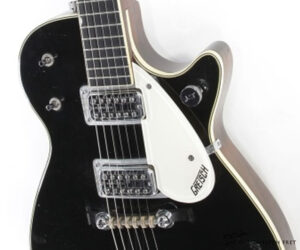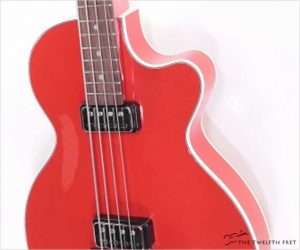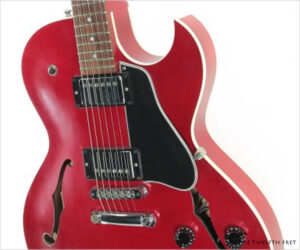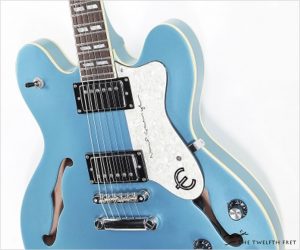When originally introduced in 1912, the Gibson L-4 appeared as a 16 inch wide, oval hole archtop, switching to F-holes in 1935. The cutaway body L-4C appeared in 1949 and by 1956 had displaced the non-cutaway model. In Gibson’s naming convention, the ‘C’ was dropped some years ago.
Archtop
For 2006, the Memphis plant introduced the Gibson Satin 335, a somewhat stripped down version of the classic design. Most noticeably, the fingerboard was unbound and the finish is satin – sunburst, cherry or translucent black as seen here. Later versions seem to have restored the fingerboard binding. These models were discontinued with the Memphis plant itself in 2019.
Here is an excellent Epiphone Elitist ES-335 /NA in Natural finish, built during 2006 at the Terada plant in Nagoya, Japan. This is the same plant that builds many pro-line guitars, including Gretsch models, and this guitar illustrates the quality of their work. The Epiphone Elitist ES-335 is based on an early 1960’s Gibson ES-335 with dot position markers, but it is not an exact copy.
The Hofner Club Bass, also known as the Hofner 500/2 bass, is very similar in design to the iconic 500/1 Beatle Bass, but with a traditional single cutaway ‘Club’ body. Originally built between 1965 and 1970 for Selmer, the Club bass has had a number of prominent appearances on stages; Tina Weymouth of Talking Heads used one for several tours.
Conceived as ‘The Ultimate Signature Guitar,’ this autographed Gibson ES-335 Dot, conceived in 1991, boasts a striking Alpine White finish adorned with signatures from renowned guitarists. Originally donated by Gibson, this guitar became a centerpiece for a signature collection themed around the ‘Most Important Guitarists of the Last 10 Years,’ as chosen by readers of GUITAR Magazine in 1993.
Here we’re looking at a Gibson L-4CES (CES for Cutaway Electric Spanish) in Natural lacquer finish, dating to January 11 1989 and built at Nashville. This example is in overall very good, clean and original condition with light wear to the back finish and very light fret wear. The gold plating on the pickups shows typical wear to the bass edge, but the bridge, tailpiece and tuner plating has very little wear.
Built from 1991 to 2003 in Memphis, the Gibson ES-135 P100 was a single Florentine cutaway, semi-hollow thinline with a pair of P100 hum-cancelling pickups. From 1956 to 1958, the ES-135 existed as a renamed ES-130, a full-depth, single-cutaway archtop with one or two P-90 pickups. The ES-130 was introduced in 1954, renamed in 1956 to the ES-135, and discontinued in 1958.
Here’s a fantastic piece from early 1959, a Gretsch 6128 Duo Jet in Black Top finish. Just after this guitar was built, Gretsch altered the design to add a zero fret to the fingerboard. This is a great looking, playing and sounding guitar. It is one of the lightest electrics available at just over seven pounds (3.2kg), it plays well, and these Filter ‘Tron pickups are very good sounding. Introduced in 1954 just after the solid body, Pine capped 6130 Roundup, the chambered Duo Jet was aimed directly at Gibson’s Les Paul model, with a similar shape but very different yet hidden construction differences.
The Cromwell G-4 archtop guitar was built by Gibson from 1935 to 1939 and sold to various retailers and catalog distributors. Inside this guitar, visible through the bass F-hole is a well-preserved yellow label reading ‘New York Band Instrument Company’ indicating that it was sold by that company, at the time a large music store in New York City, but gone by 1950.
Seen here is a Gibson L-4C cutaway archtop acoustic guitar with an original DeArmond Rhythm Chief 1100 pickup with its ‘Monkey on a Stick’ mount. This fine vintage guitar very much looks the part, and it plays well. The 16-inch wide Gibson L-4C was introduced in 1949 and came to replace the non-cutaway L-4. That model first appeared in 1912 as an oval-hole archtop, with F-holes becoming available in 1935 and finally discontinued in 1956.
Introduced in 2013 at the winter NAMM show, the Godin Montreal Premiere HT has a thin trestle-braced arched top body and is ideal for jazz players. This Godin Montreal Premiere HT example is in very good, clean condition, dates to the first months of 2016 and was built at the Godin shops in La Patrie, Quebec with a mixture of domestic and imported woods. The top, back and sides are locally sourced Wild Cherry laminate with a Trestle or ML bracing system that supports and damps the body while reducing weight, and provides anchor points for the stop tailpiece.
Here’ s a new, old stock 2015 Hofner Gold Label Club Bass in solid red! The Club Bass is also known as the 500/2 – the 500/1 is the iconic violin shaped ‘Beatle Bass’. This is a ‘Gold Label’ model, one of a limited edition in custom colour. These models are built at the primary Hofner plant in Hagenau, Bavaria and are not always easy to find available for sale.
This Gibson Tal Farlow is a rare model. Named after the renowned jazz guitarist Tal Farlow, who played Gibson guitars throughout the ’50s where this model was designed to meet Farlow’s demands for a guitar that combined superb playability with a rich, resonant tone.
The Eastman AR910CE LH – Left Handed – is pretty much the top of the Eastman line of archtop electrics, with solid wood throughout and carved top and back. It’s fairly unusual to see an available high quality left-handed archtop. The top and its bracing are solid Spruce, paired with nicely flamed and matched Flame Maple for the sides and back.
The Gibson ES-175D was formally introduced in 1953 as the Double P-90 pickup version of the single-pickup ES-175. Informally, a few were shipped in 1951 and 1952 but without the ‘D’ designation. This guitar came onto the scene in 1949 as a single pickup archtop with a sharp Florentine cutaway, Maple laminate body construction, Mahogany neck and Rosewood bridge and bound fingerboard.
The Gibson ES-135H was the ‘Humbucker’ equipped version of the ES-135, a single-cut Semi-Hollow Archtop built in Memphis from 1991 to 2004. Many of these models used P-100 pickups – a stacked humbucker with the outline of a P-90. Some models used a Trapeze tailpiece, others as seen here a standard Tune-O-Matic and Stop Tailpiece combination.
This is a wonderful rarity. Built during 1953, this is an early Gibson ES-295 in good, clean and largely original condition, showing some honest finish wear and tear from real use over the decades. It’s easy to confuse the Gibson ES-295 with the classic ES-175, and there’s a good reason – they are the same guitar, but the ES-295 has a double gold finish and when introduced, two pickups instead of one.
Listed from 1935 to 1941, the Martin R-17 was one of a few arched top, flat back models in the Martin catalog, featuring a Mahogany top, back and sides. Its sibling, the R-18, had a solid, shaped Spruce top with Mahogany elsewhere; Brazilian Rosewood was used for the head plate, bridge, and fingerboard. Early examples of both models used 12 fret necks but soon gained the more popular 14 fret configuration.
Influenced heavily by the Sheraton used by Noel Gallagher in Oasis, the Epiphone Supernova was built from 1997 to 2005, with a signature pickguard and features making it the Noel Gallagher Supernova. It was available in a variety of finishes including the Manchester Blue seen here, and a custom Union Jack graphic.
The Eastman T59 V is a take on one of the most successful and influential of Ted McCarty’s innovations, the thinline, semi-hollow archtop electric guitar. Around 1957, Gibson was looking to update its product line to address a number of issues, one of which was the rise in amplified stage volumes causing feedback. While the engineering team is credited with most of the design, it was apparently president Ted McCarty’s idea to put a solid Maple block through the center of the guitar.
The Eastman Romeo SC is a new limited edition thinline and largely hollow archtop electric design by Otto D’Ambrosio at the Eastman Custom Shop in California. Intended as an imagining of what ‘The Telecaster of the Archtop World’ would be, the Romeo started with defining its balance and player’s hand positions. The body is fairly small at 14.75 inches across, and the ‘Single Cut’ design gives plenty of access to the fretboard.
The Eastman T486B Thinline is an excellent take on the classic semi-hollow design introduced by Ted McCarty, president of Gibson, with the 1958 ES-335. Like most other versions of this design, the Eastman T486B uses pressed Maple Laminate for the top, back and sides, with a Maple block running down the center of the body. The top has a pair of F holes, and here they are bound. On the Eastman, the neck is Maple with a bound Ebony fingerboard sporting Split Block Parallelogram inlays (similar to an ES-345).
The Eastman MDC805 Mandocello is a wonderful, rich sounding instrument that works well as a solo, ensemble or accompaniment instrument in a wide range of styles and genres, from Celtic to Classical, Latin and back again. The Mandocello had been in existence for some centuries in Europe, beginning with flat back and then bowl back. However, in 1905 Orville Gibson’s company began producing mandolin family instruments, including Mandocello models that drew from his blending of violin and guitar concepts.
This brand-new Douglas Harrison GB Custom thinline, chambered archtop guitar is just passing through, and we had to show it off.
























